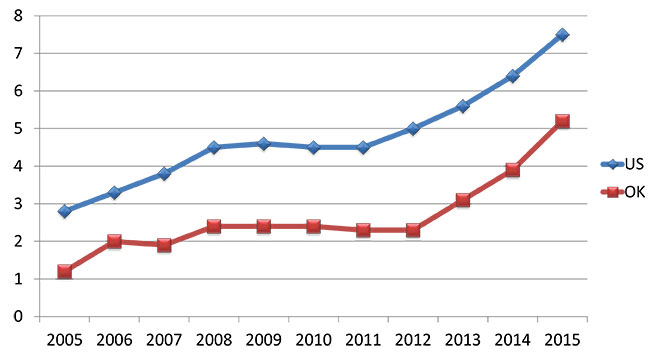Syphilis Outbreak in Oklahoma
More than 80 diagnosed syphilis cases just in Oklahoma County.1
On March 24, 2017, Oklahoma City-County Health Department (OCCHD) and Oklahoma State Department of Health (OSDH) confirmed that the outbreak of syphilis is connected to a specific social network between the ages of 14 and 47 years old.1
The most common risk factors associated with this increase include drug use, exchanging sex for money or drugs, or having multiple sex partners.1
Any person, regardless of age, can be infected with syphilis by direct contact with a syphilis sore during vaginal, anal or oral sex.4 Sores can be found around the penis, vagina, anus or in the mouth.4 Syphilis can even spread from an infected mother to her unborn baby, which can lead to loss of the pregnancy, low birth weight or death of the baby shortly after birth.4

In 2015, a total of 209 cases of primary and secondary syphilis were reported in Oklahoma. That number increased to 264 in 2016. The 82 known cases diagnosed in Oklahoma County as of April 2, 2017 is 31.1% of last year’s total for the entire state.5
Primary and Secondary Syphillis Rates per 100,000 Populations,
Oklahoma and U.S. 2005-20153,4

What is syphilis?
Syphilis is a sexually transmitted infection that can cause serious health problems if it is not treated.4
Syphilis is divided into stages (primary, secondary, latent, and late), and there are different signs and symptoms associated with each stage.4
Difference stages of syphilis infection, different symptoms
Primary syphilis generally has a sore or sores at the original infection site. These sores can be firm, round and painless.4
Secondary syphilis symptoms include skin rash, swollen lymph nodes and fever.4
Latent syphilis has no signs or symptoms.4
Tertiary or third-level syphilis is associated with severe medical problems impacting the heart, brain and other organs.4

Graphic retrieved from http://healthlifemedia.com/healthy/understanding-stds-syphilis/
How is syphilis spread?
You can get syphilis by direct contact with a syphilis sore during vaginal, anal, or oral sex. Sores can be found on or around the penis, vagina, or anus, or in the rectum, on the lips, or in the mouth. Syphilis can also be spread from an infected mother to her unborn baby.
How can I reduce my risk of getting syphilis?
The only way to avoid STDs is to not have vaginal, anal, or oral sex.
If you are sexually active, you can do the following things to lower your chances of getting syphilis:
Being in a long-term mutually-monogamous relationship with a partner who has been tested for syphilis and does not have syphilis;
Using latex condoms, the right way, (https://www.cdc.gov/condomeffectiveness/male-condom-use.html) every time you have sex. Condoms prevent transmission of syphilis by preventing contact with a sore. Sometimes sores occur in areas not covered by a condom. Contact with these sores can still transmit syphilis.
Choose to prevent further spreading and avoid the potential lifelong effects of this infection.
Ask your health care provider about syphilis testing, or test through QuestDirect without needing a provider’s order. Visit QuestDirect for more information on Syphilis testing.
- OKC-County Health Department. OCCHD AND OSDH ADDRESSING SYPHILIS OUTBREAK. March 24, 2017. Retrieved from https://www.occhd.org/pressroom/occhd-and-osdh-addressing-syphilis-outbreak
- https://www.ok.gov/health2/documents/Primary%20and%20Secondary%20Syphili...
- Oklahoma State Health Department, retrieved from https://www.ok.gov/health2/documents/Primary%20and%20Secondary%20Syphili...
- Centers for Disease Control and Prevention. Retrieved from https://www.cdc.gov/std/syphilis/syphilis-feb-2017.pdf
- Tapia, Eriech. "Oklahoma County outpaces nation on most STDs." The Oklahoman, July 8, 2017. http://newsok.com/article/5555620




CLIA